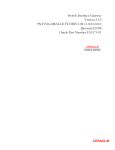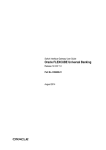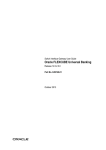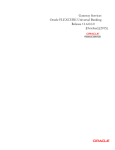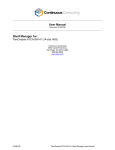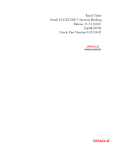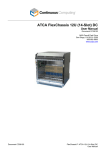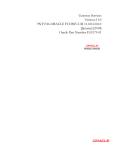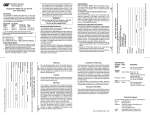Download Switch Interface Gateway User Manual
Transcript
Switch Interface Gateway Oracle FLEXCUBE Universal Banking Release 11.3.1.0.0LA [January] [2012] Oracle Part Number E51536-01 Switch Interface Gateway Table of Contents 1. ABOUT THIS MANUAL................................................................................................................................ 1-1 1.1 INTRODUCTION ........................................................................................................................................... 1-1 1.2 AUDIENCE .................................................................................................................................................. 1-1 1.3 ABBREVIATIONS ......................................................................................................................................... 1-1 1.4 ORGANIZATION .......................................................................................................................................... 1-2 1.4.2 Related Documents ............................................................................................................................ 1-2 1.5 GLOSSARY OF ICONS .................................................................................................................................. 1-3 2. SWITCH INTERFACE GATEWAY ............................................................................................................ 2-1 2.1 INTRODUCTION ........................................................................................................................................... 2-1 2.2 INTERFACE FUNCTIONALITIES .................................................................................................................... 2-1 2.2.1 ATM Transactions ............................................................................................................................. 2-1 2.2.2 Point Of Sale Transactions ................................................................................................................ 2-3 2.2.3 IVR Transactions ............................................................................................................................... 2-4 2.3 GATEWAY MAINTENANCE FOR SWITCH INTERFACE ................................................................................... 2-4 2.3.1 Maintaining Upload Source............................................................................................................... 2-5 2.3.2 Maintaining FLEXSWITCH External System .................................................................................... 2-6 2.3.3 Specifying External System Functions ............................................................................................... 2-7 2.3.4 Specifying Source Preferences ........................................................................................................... 2-8 2.4 SWITCH INTERFACE MAINTENANCE ........................................................................................................... 2-9 2.4.1 Defining Currency for Currency Code Conversion ........................................................................... 2-9 2.4.2 ATM/Debit Card Mapping for Card Account Number Conversion ................................................... 2-9 2.4.3 Maintaining Channel Details ........................................................................................................... 2-10 2.4.4 Maintaining Process Code Mapping Details ................................................................................... 2-11 2.4.5 Maintaining Network Details ........................................................................................................... 2-12 2.4.6 Maintaining Merchant Details ......................................................................................................... 2-13 2.4.7 Maintaining Terminal Details.......................................................................................................... 2-14 2.4.8 Maintaining Utility Provider Details ............................................................................................... 2-16 2.4.9 Maintaining Product Types for Product Derivation ........................................................................ 2-16 2.4.10 Showing Amount Block Transactions in Account Statements .......................................................... 2-18 2.4.11 Modifying a Product Preferences Screen ........................................................................................ 2-20 2.4.12 Maintaining Charges for Non-financial Transactions ..................................................................... 2-20 2.4.13 ARC Maintenance ............................................................................................................................ 2-22 2.5 BATCH PROCESSES ................................................................................................................................... 2-22 2.5.1 Maintaining Batches for Batch Operations ..................................................................................... 2-23 2.5.2 Settlement Upload ............................................................................................................................ 2-24 2.5.3 Intra Day Batch ............................................................................................................................... 2-25 2.5.4 Viewing Transaction Monitor .......................................................................................................... 2-27 2.6 UPLOADING CARDS .................................................................................................................................. 2-28 2.7 UPLOADING TERMINAL ID ....................................................................................................................... 2-29 2.8 PROCESSING ATM CASH DEPOSITS .......................................................................................................... 2-29 3. ANNEXURE A ................................................................................................................................................. 3-1 3.1 SWITCH SOFTWARE AND CARD TRANSACTIONS BUSINESS......................................................................... 3-1 3.2 ISO8583 PROTOCOL OVERVIEW ................................................................................................................ 3-1 3.3 SWITCH TRANSACTION CATEGORIES .......................................................................................................... 3-2 3.4 ACCOUNTING ENTRIES – ATM TRANSACTIONS ......................................................................................... 3-2 3.4.1 Accounting Entries for Cash Withdrawal Transactions .................................................................... 3-2 3.4.2 Accounting Entries for Balance Enquiry ........................................................................................... 3-4 3.4.3 Accounting Entries for Deposit .......................................................................................................... 3-6 3.4.4 Accounting Entries for Funds Transfer ............................................................................................. 3-6 3.5 ACCOUNTING ENTRIES - POS PURCHASE ................................................................................................... 3-7 3.6 BALANCE HANDOFF FILE FORMATS ........................................................................................................... 3-9 3.7 NETWORK SETTLEMENT MESSAGE FORMAT ............................................................................................ 3-10 3.8 MERCHANT SETTLEMENT FILE FORMAT .................................................................................................. 3-12 3.9 MAINTAINING SWTB_PARAM TABLE ................................................................................................... 3-13 4. SCREEN GLOSSARY .................................................................................................................................... 4-1 4.1 FUNCTION ID LIST...................................................................................................................................... 4-1 1. About this Manual 1.1 Introduction This manual talks about the interface between Oracle FLEXCUBE and the Switch software system used in your bank. The maintenances required for the proper functioning of this interface, the interface workflow, validations, and processing for the interface have been documented in this manual. 1.2 Audience This manual is intended for the following User/User Roles: 1.3 Role Function Back office data entry Clerks Input functions for maintenance related to the interface Back office Managers/Officers Authorization functions Abbreviations Abbreviation Description System Unless specified, it shall always refer to Oracle FLEXCUBE CCY Currency SWITCH Switch Software BIN Bank Identification Number IMD International Member Descriptor OLTP Online Transaction Processing ATM Automatic Teller Machine POS Point Of Sale ISO International Organization for Standardization CMS Card Management System STAN System Trace Audit Number RRN Retrieval Reference Number Acquirer Bank that deploys ATM/POS for acquiring transactions Issuer Bank that issues Cards to facilitate the Transactions IC Interest and Charges – Oracle FLEXCUBE module 1-1 1.4 Abbreviation Description EOC End of Cycle EOD End of Day SAF Store and Forward Msg Message MTI Message Type Indicator PAN Primary Account Number IVR Interactive Voice Response Organization This manual is organized into the following chapters: Chapter 1 About this Manual gives information on the intended audience. It also lists the various chapters covered in this User Manual. Chapter 2 Switch Interface Gateway - helps in processing both Financial and Non-Financial Transactions. Chapter 3 Annexure A – briefs the account of the Switch software domain and the components in a Cards Transactions Business network. 1.4.1.1 Conventions Used in this Manual Important information is preceded with the symbol. ‘Switch Interface’ or ‘Interface’ in this document refers the Oracle FLEXCUBE Switch Interface that processes the transactions from Switch Software. ‘Switch’ and ‘Switch Software’ are generic terms used to refer to any OLTP product which sends transactions to Oracle FLEXCUBE Switch Interface using ISO8583 (1987/1993/2003) protocol. 1.4.2 Related Documents You may refer the following manuals for more information User Manual of the Switch System installed in your Bank (This User manual is not included in Oracle FLEXCUBE Manuals) ISO documentation on ISO8583 protocol (This manual is not included in Oracle FLEXCUBE User Manuals) 1-2 1.5 Glossary of Icons This User Manual may refer to all or some of the following icons: Icons Function New Copy Save Delete Unlock Print Close Re-open Reverse Template Roll-over Hold Authorize Liquidate Exit Sign-off Help Add row Delete row Option List Confirm Enter Query 1-3 Icons Function Execute Query Refer the Procedures User Manual for further details about the icons. 1-4 2. Switch Interface Gateway 2.1 Introduction Oracle FLEXCUBE Switch Interface helps in processing both Financial and Non-Financial Transactions. The interface helps in first validating each transaction request against the Oracle FLEXCUBE database and then posting the transactions into the system. The interface with Switch software system supports Automatic Teller Machine (ATM) and Point Of Sale (POS) transactions originating from bank terminals or from Interchanges such as VISA or MasterCard. Switch Interface also supports Interactive Voice Response (IVR) transactions. The interface functionality includes the following: Interface with support for ISO 1987/1993/2003 protocols Authorization and posting of Switch/IVR transactions into Oracle FLEXCUBE The following diagram illustrates the flow of messages via the Oracle FLEXCUBE – Switch system interface. 2.2 Interface Functionalities Following are the functionalities of the Oracle FLEXCUBE – Switch system interface. 2.2.1 ATM Transactions The following functionalities are with respect to ATM transactions. This section describes all Transactions required for Switch interface and expected accounting entries. 2.2.1.1 Cash Withdrawal During a Cash Withdrawal transaction the product is determined and the preferences are checked for processing. Amount blocking or account posting is done depending upon the class of the message. Amount blocking will include all the charge components also (for Online and Issuer). The balance amount is recorded after amount posting is done. Refer the Annexure chapter for the corresponding accounting entries. 2-1 2.2.1.2 Balance Enquiry This facility produces a quote of the Account Balance for a given account. The following balances are provided: Ledger balance Available balance Unclear balance You can select the ‘Include OD limit’ option when showing balance. Refer the Annexure chapter for the corresponding accounting entries. 2.2.1.3 Mini Statement Enquiry The interface facilitates the enquiry for Mini Statements. You can specify number of rows/the period for which the statement is to be generated. The statement can have the following columns: Originating Branch Code Transaction Literal Transaction Amount Sign Transaction Amount Flag Dr/Cr Value Date Transmission Date Transaction Reference Number The accounting entries are the same as those for Balance Enquiry 2.2.1.4 Deposit The system can automatically select the product based on the check or cash deposit. In case of cash deposits the system checks whether immediate accounting or posting is required or whether it is to be only logged. Refer the Annexure chapter for the corresponding accounting entries. 2.2.1.5 Funds Transfer This facility is used when a customer initiates a Fund Transfer between his accounts or to another customer’s account. The Switch system will send both Account numbers in ISO messages. Refer the Annexure chapter for the corresponding accounting entries. 2.2.1.6 Utility Payments This facility helps in making payments into a Utility Provider’s account. Accounting entries are same as that of Fund Transfer. 2-2 2.2.1.7 Ad-Hoc Statement Generation Request Here the customer requests a Statement through the ATM. This request is reaches the Switch interface at the bank where is passed to the Oracle FLEXCUBE system. Oracle FLEXCUBE system will generate Book Dated statements by default. The period for which the statement is required can be specified. Accounting entries are same as that of Balance Enquiry. 2.2.1.8 Cheque Book Issue The customer requests a Cheque Book via the ATM, thereby informing the bank. This request is sent to the Oracle FLEXCUBE system via the interface. The number for cheque leaves can be specified. The cheque numbers are automatically generated. Accounting entries are same as those for Balance Enquiry. ATM transaction data will be handed-off to Mantas for the branch as per the Mantas maintenance. Transactions whose value date is same as the branch EOD date is extracted for Mantas hand off. Transactions whose status is other than ‘Success or Reversed’ will not be handed off to Mantas. 2.2.2 Point Of Sale Transactions The following are the facilities provided for Point Of Sale (POS) Transactions. 2.2.2.1 POS Purchase The customer initiates a normal purchase at Merchants POS Terminal. This purchase request reaches Oracle FLEXCUBE via the Switch interface. Based on the purchase a product is identified and the preferences are considered. Depending upon the message class, either amount blocking or account posting is done. Amount blocking will include all the charge components. The account balance is recorded after the amounts are posted. Refer the Annexure chapter for the corresponding accounting entries. 2.2.2.2 Cash Advance For cash advances the Oracle FLEXCUBE product is derived at and the preferences are checked for processing. Depending upon the message class, either amount blocking or account posting is done. Amount blocking will include all the charge components. The account balance is recorded after the amounts are posted. Accounting entries are same as that of POS purchase. 2.2.2.3 Refund Accounting entries are similar to those of Cash Deposit. 2-3 2.2.2.4 Adjustments The Adjustments facility corresponds to Partial Reversals in ATM, the difference being that Cr Adjustments are also possible. Accounting entries are same as that of POS purchase. 2.2.2.5 Pre-auth-Completion Pre-auth completion involves removing amount block. Accounting entries are similar to those of POS purchase. Point of Sale (POS) transaction data will be handed-off to Mantas for the branch as per the Mantas maintenance. Transactions whose value date is same as the branch EOD date is extracted for mantas hand off. Transactions whose status is other than ‘Success or Reversed’ will not be handed off to Mantas. 2.2.3 IVR Transactions The following transactions are supported by IVR: Balance Enquiry Mini Statement Enquiry Ad-Hoc Statement Generation Request Cheque Book Issue Funds Transfer Utility Payments IVR transaction data will be handed-off to Mantas for the branch as per the Mantas maintenance. Transactions whose value date is same as the branch EOD date is extracted for Mantas hand off. Transactions whose status is other than ‘Success or Reversed’ will not be handed off to Mantas. 2.3 Gateway Maintenance for Switch Interface The following are the interface gateway maintenances done for setting up the Switch Interface Gateway. 2-4 2.3.1 Maintaining Upload Source The Upload Source is maintained in the ‘Upload Source Maintenance’ screen. You can invoke the ‘Upload Source Maintenance’ screen by typing ‘CODSORCE’ in the field at the top right corner of the Application tool bar and clicking the adjoining arrow button. In the above screen the Source Code – FLEXSWITCH – and the brief description of the source are maintained. 2-5 2.3.2 Maintaining FLEXSWITCH External System The FLEXSWITCH external system is maintained in the ‘External System - Detailed’ screen. Here you can maintain the Correlation pattern, Message pattern, and Queue names for the external system i.e. FLEXSWITCH. You can invoke the ‘External System - Detailed’ screen by typing ‘GWDEXSYS’ in the field at the top right corner of the Application tool bar and clicking the adjoining arrow button. You must specify the following in the above screen. External System and Description Specify the External System as ‘FLEXSWITCH’. You may optionally give a brief description of the External System too. Correlation Pattern - Request Select and set ‘Correlation ID’ against this field. Message Exchange Pattern – Request Message Select ‘Input only’ from the adjoining drop-down list. Message Exchange Pattern – Request Message Select ‘Full screen’ from the adjoining drop-down list. Default Response Queue Specify the default response queue as ‘SW_MDB_QUEUE_RESPONSE’. 2-6 Dead Letter Queue Specify the dead letter queue as ‘MDB_QEUEU_DLQ’. XSD Validation Required Select this checkbox if the request xml and response xml has to be validated against the XSD. Register Response Queue Message Id Select this checkbox to register the response queue message Id. External System Queues Give the External IN-QUEUE and RESPONSE-QUEUE for Switch. 2.3.3 Specifying External System Functions You can specify the external system’s functions in the ‘External System Functions – Detailed’ screen. Here you can maintain Function ID, Action, Service name and Operation code for the Switch Interface Gateway External system. You can invoke the ‘External System Functions – Detailed’ screen by typing ‘GWDEXFUN’ in the field at the top right corner of the Application tool bar and clicking the adjoining arrow button. External System Select the External system – FLEXSWITCH – from the list of options available. Function Select the Function id from list. Once you have entered the above details the following fields are filled automatically: Action Service Name 2-7 Operation Code 2.3.4 Specifying Source Preferences You can set the preferences for the External system in the ‘Upload Source Preferences Maintenance’ screen. You can invoke the ‘Upload Source Preferences Maintenance’ screen by typing ‘CODUPLDM’ in the field at the top right corner of the Application tool bar and clicking the adjoining arrow button. Source Code Select Source Code - FLEXSWITCH - from the list. Module Code Select Module Code from the list of options. On Override Select ‘Ignore’ to ignore error handling overrides. On Exception Select ‘Reject’ to reject error handling exceptions. Post Upload Status Select ‘Authorized’ for the uploads to be automatically authorized on completion of the upload process. Leave the following checkboxes cleared: Allow Deferred Processing Allow EOD with Deferred Allow Delete 2-8 2.4 Switch Interface Maintenance You must perform the following maintenances for the Oracle FLEXCUBE – Switch system interface. 2.4.1 Defining Currency for Currency Code Conversion ISO numeric currency codes are converted into Oracle FLEXCUBE’s alpha numeric currency code. The definition for the conversion is maintained against the ‘ISO Numeric Currency Code’ field in the Currency Definition screen as shown below. You can invoke the ‘Currency Definition’ screen by typing ‘CYDCDEFN’ in the field at the top right corner of the Application tool bar and clicking the adjoining arrow button. 2.4.2 ATM/Debit Card Mapping for Card Account Number Conversion The interface facilitates conversion of ATM Card Number and Card Account Number to Oracle FLEXCUBE’s alphanumeric account number. For this facility you must map the card account numbers to Oracle FLEXCUBE account numbers. This mapping can be done in the ‘Debit Card Oracle FLEXCUBE Account Mapping’ screen. Upload will be provided for this date tends to be in bulk and banks will prefer to maintain it using handoffs. 2-9 You can invoke the ‘ATM/Debit Card FCC Account Mapping’ screen by typing ‘SWDATMCD’ in the field at the top right corner of the Application tool bar and clicking the adjoining arrow button. You must maintain the following mandatory fields in the above screen. ATM/Debit Card Number Specify the card number. Card Account Number Specify the card account number here. This must be a unique combination. The Card Account Number is mandatory only when the transaction account is the Card Account and not the account maintained in Oracle FLEXCUBE. Branch Specify the card issuer branch from the list of options available alongside. Account Number From the list of options available alongside, specify the Oracle FLEXCUBE account number for which the card has been issued. 2.4.3 Maintaining Channel Details You can define channel names using ‘Channel Details’ screen. You can invoke this screen by typing ‘SWDCHNID’ in the field at the top right corner of the Application tool bar and clicking the adjoining arrow button. 2-10 Specify the following details here: Channel Specify the channels like ATM/IVR/POS and ALL. These channels are factory shipped. Description Enter a brief description about channels. 2.4.4 Maintaining Process Code Mapping Details All transaction requests from the switch system are conveyed in ISO transaction codes. These are resolved into corresponding specific transactions in Oracle FLEXCUBE. For this you must maintain the ISO transaction code and its corresponding Oracle FLEXCUBE transaction literal in the ‘Process Code Mapping Details’ maintenance screen. 2-11 Create and maintain process code types for all Oracle FLEXCUBE literals in the ‘Process Code Mapping Details’ screen. You can invoke the ‘Process Code Mapping Details’ screen by typing ‘SWDFCLTL’ in the field at the top right corner of the Application tool bar and clicking the adjoining arrow button.. Specify the following details here. Oracle FLEXCUBE Literal Select the Oracle FLEXCUBE literal from the drop-down list available alongside. This is a mandatory field. You can enter additional information in the editor that is displayed on clicking the adjoining icon. Process Code Type Specify the first two characters from the ISO process code here. It is a two-digit unique number. This is a mandatory field. Channel Specify a channel that should be used. The adjoining option list displays all valid channels maintained in the system. You can choose the appropriate one. External Transaction Code Specify the external transaction code here. This is an optional field. Description Optionally you can specify a brief description of your maintenance here. 2.4.5 Maintaining Network Details For every network interacting with the SWITCH system, you need to maintain the Network, Issuers and Acquirer details. This maintenance is done in the ‘Network Details’ screen as shown below. 2-12 You can invoke the ‘Network Details’ screen by typing ‘SWDNWDET’ in the field at the top right corner of the Application tool bar and clicking the adjoining arrow button. Network ID Specify the Network Id of the card issuing agency here. This is a mandatory field. Account Number and Account Branch Specify the Account Number from the list of options available alongside each field. This account number – a Nostro account – belongs to the specify Network Id. This is used to post entries when the corresponding network is involved in the transaction. It is a mandatory field. Depending on the Account Number selected, the corresponding Account Branch is displayed. Issuer and Acquirer Details Acquirer is the Bank that owns the ATM and POS terminals and offer access to card holders from their own and also other banks. Issuer is the Bank that issues the Card to account holders and authorizes/posts transactions. You must maintain the Issuer and Acquirer Banks for the network here. Specify the BIN (Bank Identification Number ) alias IMD ( International Member Descriptor ) to identify the Acquirer and Issuer. You may also specify a description for each. 2.4.6 Maintaining Merchant Details You may have various POS machines at different locations, each having their own Merchant Details. For facilitating POS transaction you must maintain the Merchant Details in the screen as shown below. 2-13 You can invoke the ‘Merchant Details’ screen by typing ‘SWDMRCID’ in the field at the top right corner of the Application tool bar and clicking the adjoining arrow button. Merchant Id Specify the Merchant ID of the POS machine here. This is mandatory. Account Branch Specify the related branch of the Merchant’s account here. This is mandatory. Account Number Specify the Merchant’s account number here. This is mandatory. This will be the Oracle FLEXCUBE account to which postings will be done. 2.4.7 Maintaining Terminal Details You must maintain Terminal Details such as the Originating branch, Cash GL and Terminal ID for each ATM or POS Terminal. This is done in the ‘Terminal Details’ screen as shown below. 2-14 You can invoke the ‘Terminal Details’ screen by typing ‘SWDTRMID’ in the field at the top right corner of the Application tool bar and clicking the adjoining arrow button. Terminal ID Specify the unique terminal ID of the ATM machine/POS machine to uniquely identify then. This is mandatory. Channel Specify a channel that should be used. The adjoining option list displays all valid channels maintained in the system. You can choose the appropriate one. Note the following: If you select the channel as IVR, then you need to leave ‘Intelligent Deposit’ option unchecked. If you select the channel as IVR, then the options ‘Cash General Ledger number’ and ‘Merchant ID’ should be blank. Originating Branch Specify the Originating Branch from the list of options given alongside. It is either the issuer branch of the POS or the ATM branch, as the case may be. Cash GL Account This field is enabled and is mandatory for ATM type terminals only. Specify the Cash GL Account form the adjoining list of options. Merchant ID This field is enabled and is mandatory for POS type terminals only. Specify the Merchant ID here. Terminal Address Specify the address of the terminal here. 2-15 Intelligent Deposits This checkbox is valid only for ATM terminals. Select this checkbox to indicate the ATM provides Intelligent Deposits facility. In the Intelligent Deposits facility, accounting entries are done as soon as the customer makes the Deposit. 2.4.8 Maintaining Utility Provider Details Maintain the details of a utility provider in the ‘Utility Provider Details’ screen. You can invoke the ‘Utility Provider Details’ screen by typing ‘SWDUPDET’ in the field at the top right corner of the Application tool bar and clicking the adjoining arrow button. Utility Provider Id Specify the Utility Provider Id here. Account Branch Specify the related branch of the Merchant’s account here. This is mandatory. Account Number Specify the Merchant’s account number here. This is mandatory. This will be the Oracle FLEXCUBE account to which postings will be done. Description Optionally you can give a brief description of the utility provider here. 2.4.9 Maintaining Product Types for Product Derivation Every transaction request from the switch system is assigned under a particular product type. This maintenance is done in the ‘Product Type Maintenance’ screen. Here, you can map products to Oracle FLEXCUBE literals. 2-16 For every transaction request the Oracle FLEXCUBE product is derived based on the Category, Oracle FLEXCUBE literal and the Customer Category. You can invoke the ‘Product Type Maintenance’ screen by typing ‘SWDPRMAP’ in the field at the top right corner of the Application tool bar and clicking the adjoining arrow button. You can specify the following details here. Oracle FLEXCUBE Literal Select a three digit literal from the list of options available alongside. Category Select the category of the transaction – On-Us, Off-Us or Remote-On-Us – from the list of options available alongside. Customer Category Select a customer category from the list of options available alongside. Channel Specify the channel that should be used for transaction. The adjoining option list displays all the channels maintained in the system. ATM, POS and IVR requests may come from the same port or from different ports based on the configuration done in the property file. If they are configured to arrive from different ports, then the channel is identified based on the port number. If they are configured to arrive from the same port then the channel is identified as ‘ALL’. It is also possible that some of the channels alone share a port. Product Code From the list of options available alongside, select the Oracle FLEXCUBE product code to be mapped to the specified literal. 2-17 Network Select the network from the list of options available alongside. Acquirer Country Select the country of the acquirer from the list of options available alongside. 2.4.10 Showing Amount Block Transactions in Account Statements You can have any field from the transaction log included in the Customer Account statement generation. Additionally you can also choose to include transactions that resulted in amount blocks. You can invoke the ‘Amount Block Input’ screen by typing ‘CADAMBLK’ in the field at the top right corner of the Application tool bar and clicking the adjoining arrow button. Select ‘New’ from the Actions menu in the Application toolbar. The system will display ‘Transaction Branch’ screen. Here you can select the transaction branch. Here you are allowed to book other branch transactions from the logged in branch. Also, you can query other branch transactions from the logged in branch. The system defaults the logged-in branch by default as the transaction branch. Transaction Branch Select the appropriate branch from the list of branches available in the option list. This screen will be available only for those users who has ‘Multi Branch Operational’ check box enabled at ‘User Maintenance’ Screen. While clicking ‘Ok’ button, the system validates the access rights of the selected branch and function for the user. If you don’t have appropriate rights on the selected branch and function, the system would raise an error message. If you select a valid branch, the system updates the same as transaction branch and the transaction would be posted for this branch. The system performs the action level access rights validation only on ‘Save’ operation. After selecting the Transaction Branch, you can enter the remaining details in the ‘Amount Block Input’ screen. 2-18 Account Number Specify the Oracle FLEXCUBE account number for blocking the amount. This field is mandatory. Amount Block Number Amount block number is unique and is created after the amount block creation. Amount Specify the Amount blocked. This field is mandatory. Expiry Date Specify the expiry date of the Amount Block. Effective Date Specify the date from which the Amount block is effective. Amount Block This list shows Switch, Oracle FLEXCUBE, and Pre-Auth. If the amount block is done via Switch, then it must be selected here. Remark Optionally you may add your remarks here. 2-19 2.4.11 Modifying a Product Preferences Screen During the implementation of the Switch interface system you can use the following facility to modify the ‘Preferences’ screen for a product. You can invoke the ‘Retail Teller Product Preferences’ screen by typing ‘DEDRTPRM’ in the field at the top right corner of the Application tool bar and clicking the adjoining arrow button. You may select the following checkboxes if you wish to have them in a product’s ‘Preferences’ screen. Partial Reversals allowed Reversal Includes charges - Reversal should reverse charges Switch product 2.4.12 Maintaining Charges for Non-financial Transactions You can have the following non financial transactions charged: Balance Enquiry Cheque Book request Mini statement request Ad-hoc statement request You can facilitate the above service by first using the ‘Retail Teller Product Maintenance’ to maintain a Retail Teller product as shown below. You can invoke the ‘Retail Teller Product Maintenance’ screen by typing ‘DEDRTPRM’ in the field at the top right corner of the Application tool bar and clicking the adjoining arrow button. 2-20 You must next do the ARC Maintenance for the above product in the ‘ARC Maintenance’ screen as shown below. In the ARC Maintenance you can maintain the charges for the various nonfinancial transactions under the CHARGE 1-5 tabs. The transaction amounts will be zero and so the accounting entries will have only the charges. 2-21 2.4.13 ARC Maintenance You can maintain the charges for the product type in the ARC Maintenance screen. You can invoke the 'ARC Maintenance’ screen by typing ‘IFDATMMN’ in the field at the top right corner of the Application tool bar and clicking the adjoining arrow button. The ARC maintenance is done for the product Cash Withdrawal (CHWL).You can maintain charges (under charge tabs CHARGE1 -5) for both financial and non-financial transactions. CHARGE1 must be the Transaction Fee. The Description under ‘CHARGE1’ tab should be given as TXN_FEE. CHARGE2 must be the Transaction Processing Fee. The Description under the ‘CHARGE2’ tab should be given as TXN_PROCESS_FEE. For more details on ARC Maintenance, refer the relevant Oracle FLEXCUBE user manual. 2.5 Batch Processes The following batch processes are part of the Oracle FLEXCUBE – Switch Interface. For more information on Batch Processes refer the corresponding Oracle FLEXCUBE user manual. 2-22 2.5.1 Maintaining Batches for Batch Operations You can maintain the following batches for Batch Operations in the ‘Batch EOD Function Inputs’ screen: SWSWRECN – Switch Reconciliation Batch SWDPRCRT – Process Transaction Batch SWNETSET – Network Settlement Batch SWMERSET – Merchant Settlement Batch SWDPURGE – Adhoc Purge Batch SWDRETBT – Retry and Suspense Processing Batch. You can invoke the ‘Batch EOD Function Inputs’ screen by typing ‘BADEODFN’ in the field at the top right corner of the Application tool bar and clicking the adjoining arrow button. 2-23 2.5.2 Settlement Upload You can perform settlement uploads for the Switch, Network and Merchant categories from the ‘Settlement Upload’ screen. You can invoke the ‘Settlement Upload’ screen by typing ‘SWDUPLST’ in the field at the top right corner of the Application tool bar and clicking the adjoining arrow button. You need to specify the following details. Channel Select the channel to be used while uploading settlement files into Oracle FLEXCUBE, from the adjoining drop-down list. The following values are available: ALL ATM POS IVR Based on the channel specified, the system will pick up the appropriate Retail Teller product and ARC maintenance for settlement and reconciliation processing. Category The categories for which you can perform settlement upload are: Switch Network Merchant In the above screen you can specify the Reconciliation File/Network file/Merchant upload file’s name and path. 2-24 2.5.3 Intra Day Batch You can run the following Functions in the ‘Intra Day Batch Start’ screen: SWSWRECN – This is the batch for the reconciliation file. SWNETSET– This is the batch for the network file. SWDPRCRT – This batch removes the amount block. SWMERSET – This is the batch for Merchant settlement. SWDPURGE – This is the batch for Adhoc purge of transaction data to history table. SWDRETBT – This is the batch for retry and suspense processing. Once the batches are successfully run, their corresponding accounting entries will be posted. You can invoke the 'Intra Day Batch Start’ screen by typing ‘BADIDBAT’ in the field at the top right corner of the Application tool bar and clicking the adjoining arrow button. Click ‘Ok’ button to initiate the Intra Day Batch process. You can monitor the status of successfully run SWSWRECN and SWNETSET functions in the ‘Intra Day Batch Start Monitor’ screen. 2-25 You can invoke the 'Intra Day Batch Start Monitor’ screen by typing ‘BASIDMTR’ in the field at the top right corner of the Application tool bar and clicking the adjoining arrow button. 2-26 2.5.4 Viewing Transaction Monitor You can view a summary of transaction status in the ‘Switch Transaction Monitor’ screen. You can invoke this screen by typing ‘SWDTXQRY’ in the field at the top right corner of the Application tool bar and clicking the adjoining arrow button. Here you can view the following details. Transaction Log You can view the number of transactions in the following statuses. WIP Success Repair Failed Total Retry Log You can view the retry log of transactions in the following statuses. Unprocessed Success Suspense Reversed Total 2-27 2.6 Uploading Cards You can upload card account mapping maintenance through the ‘Debit Card FCC Account Upload’ screen. You can invoke this screen by typing ‘SWDCDUPL’ in the field at the top right corner of the Application tool bar and clicking the adjoining arrow button. You can specify the following details. File Name Specify the name of the file that should be uploaded. File Path Specify the path from where the file should be picked up for uploading. Intraday Sequence Number The system generates a sequence number for the upload transaction and displays it here. 2-28 2.7 Uploading Terminal ID You can upload terminal ID maintenance through the ‘Terminal ID Upload’ screen. You can invoke this screen by typing ‘SWDTIDUP’ in the field at the top right corner of the Application tool bar and clicking the adjoining arrow button. You can specify the following details. File Name Specify the name of the file that should be uploaded. File Path Specify the path from where the file should be picked up for uploading. Intraday Sequence No The system generates a sequence number for the upload transaction and displays it here. 2.8 Processing ATM Cash Deposits Cash deposits can happen at ATMs which don’t have the Intelligent Deposits facility. For such ATMs the ‘Intelligent Deposits’ option also is not selected in Terminal Details maintenance. In the case of such ATMs the cash deposit details are stored as a ‘Tanked Deposit Transaction’ until you can validate the transaction amount. For Tanked Deposit Transactions, accounting entries are not passed until the transaction amount is validated and authorised. You can validate the transaction amounts of Tanked Deposit Transactions in the ‘ATM Cash Deposit Details’ screen. 2-29 You can invoke the ‘ATM Cash Deposit Details’ screen by typing ‘SWDCSHDP’ in the field at the top right corner of the Application tool bar and clicking the adjoining arrow button. You must validate the tanked deposit by specifying the actual transaction amount in the ‘Actual Amount’ field. Once done, click ‘Exit’ button to exit and save your validation. The following details are displayed in the above screen. The details give information regarding the cash deposit. Transaction Account This displays the Oracle FLEXCUBE account which has been linked to the Card Account Number. Transaction Currency This field displays the Oracle FLEXCUBE currency which has been linked to the numeric currency in the ISO message. Transaction Amount This is the deposit amount sent through the ISO message. Local Currency Amount If a local currency has been maintained then the transaction amount is converted to the local currency and displayed here. Transaction Date This is the Deposit transaction date as sent in the ISO message. Transaction Reference Number This is the Transaction Reference Number which is generated for the deposit transaction. 2-30 Charge Currency and Charge Currency 1-4 Charges may be levied as Transaction Fee, Transaction Processing Fee and as other charges maintained in Oracle FLEXCUBE. The currency that has been defined for the corresponding charge is displayed here. Charge Amount and Charge Amount 1-4 The charge amount for the corresponding charge is displayed here. Charge Description and Charge Description 1-4 The description for the charge is displayed here. 2-31 3. Annexure A 3.1 Switch Software and Card Transactions Business The following is a brief account of the Switch software domain and the components in a Cards Transactions Business network. The following diagram illustrates the components in the switch network. ATMs and POS Terminals are connected with the Switch Software system using proprietary message protocol depending on the upon the terminal device type. Switch software is also connected with ‘Interchanges’ like VISA and MasterCard. A switch software system provides the following functionalities: Maintaining all ATM / POS / Interchange information Maintaining Card Number to Account Number Linkages Receiving Card Transactions from ATM / POS terminals and checking PIN and Card status Forwarding the Transactions to Host Banking Systems like Oracle FLEXCUBE after converting proprietary protocol into ISO8583 protocol Performing ‘stand-in’ authorization incase of Link to Host systems are down Refreshing Account balances from Banking Systems ( to use Stand-in ) 3.2 ISO8583 Protocol Overview ISO8583 protocol is called the ‘Financial Transaction Standard for Card originated messages and Interchange message specifications’. This protocol provides for the exchange of information between an ‘Acquirer’ and an ‘Issuer’ for card transactions. The terms ‘Acquirer’ and ‘Issuer’ are explained below. Acquirer An Acquirer is the Bank that deploys the self servicing devices like ATM /POS and may have a switch system software and Interchange connections. 3-1 Issuer An Issuer is the Bank that issues cards to its customers. It has the database of accounts and is connected to the Switch system software. In the course of transactions via the switch system, Issuers respond to Acquirers with approval or rejection messages. 3.3 Switch Transaction Categories The Switch system transaction flows can happen in three different ways. Each flow is termed as a Category of the transaction. The categories are from the Issuer bank’s perspective. The following example explains the categories. Consider that Oracle FLEXCUBE system is installed at YOUR BANK. Consider another bank, say HSBC, with which you can have card based transactions. Then the following are the categories depending upon which bank’s Card or Terminal is involved. 3.4 Cards ATM/POS Terminal Category of Transaction YOUR BANK Cards YOUR BANK On-Us YOUR BANK Cards HSBC Remote-On-Us HSBC Cards YOUR BANK Off-Us Accounting Entries – ATM Transactions The following are the various accounting entries for ATM Transactions. 3.4.1 Accounting Entries for Cash Withdrawal Transactions ON US DR CUSTOMER A/C BILL-AMT (converted to a/c ccy) CR CASH GL DR CUSTOMER A/C TXN_FEE (converted to a/c ccy) CR P&L DR CUSTOMER A/C TXN_PROCESS_FEE (converted to a/c ccy) CR P&L DR CUSTOMER A/C FC_CHARGES (converted to a/c ccy) CR P&L GL GL GL TXN-AMT TXN_FEE TXN_PROCESS_FEE FC_CHARGES 3-2 Remote – ON US DR CUSTOMER A/C BILL-AMT ( converted to a/c ccy) CR NETWORK SUSPENSE GL SETL_AMT DR CUSTOMER A/C TXN_FEE (converted to a/c ccy) CR NETWORK SUSPENSE GL TXN_FEE DR CUSTOMER A/C CR NETWORK SUSPENSE GL TXN_PROCESS_FEE DR CUSTOMER A/C FC_CHARGES (converted to a/c ccy) CR P&L FC_CHARGES TXN_PROCESS_FEE (converted to a/c ccy) GL During Network Settlement DR NETWORK SUSPENSE GL CR NETWORK NOSTRO A/C SETL_AMT (converted to a/c ccy) DR NETWORK SUSPENSE GL SETL_AMT TXN_FEE CR NETWORK NOSTRO A/C TXN_FEE (converted to a/c ccy) DR NETWORK SUSPENSE GL CR NETWORK NOSTRO A/C TXN_PROCESS_FEE (converted to a/c ccy) TXN_PROCESS_FEE OFF- US DR NETWORK SUSPENSE GL SETL-AMT (converted to a/c ccy) CR CASH GL TXN-AMT DR NETWORK SUSPENSE GL TXN_FEE (converted to setl ccy) CR P&L GL TXN_FEE 3-3 DR NETWORK SUSPENSE GL TXN_PROCESS_FEE (converted to a/c ccy) CR P&L GL TXN_PROCESS_FEE During Network Settlement DR NETWORK NOSTRO A/C SETL_AMT ( converted to a/c ccy) CR NETWORK SUSPENSE GL DR NETWORK NOSTRO A/C TXN_FEE CR NETWORK SUSPENSE GL DR NETWORK NOSTRO A/C TXN_PROCESS_FEE ( converted to a/c ccy) CR NETWORK SUSPENSE GL SETL_AMT TXN_FEE (converted to a/c ccy) TXN_PROCESS_FEE 3.4.2 Accounting Entries for Balance Enquiry ON US DR CUSTOMER A/C CR P&L DR CUSTOMER A/C CR P&L DR CUSTOMER A/C CR P&L TXN_FEE (converted to a/c ccy) GL TXN_FEE TXN_PROCESS_FEE (converted to a/c ccy) GL TXN_PROCESS_FEE FC_CHARGES (converted to a/c ccy) GL FC_CHARGES R-ONUS DR CUSTOMER A/C TXN_FEE (converted to a/c ccy) CR NETWORK SUSPENSE GL DR CUSTOMER A/C CR NETWORK SUSPENSE GL TXN_FEE TXN_PROCESS_FEE (converted to a/c ccy) TXN_PROCESS_FEE 3-4 DR CUSTOMER A/C CR P&L FC_CHARGES (converted to a/c ccy) GL FC_CHARGES During Network Settlement DR NETWORK SUSPENSE GL TXN_FEE CR NETWORK NOSTRO A/C TXN_FEE (converted to a/c ccy) DR NETWORK SUSPENSE GL CR NETWORK NOSTRO A/C TXN_PROCESS_FEE (converted to a/c ccy) TXN_PROCESS_FEE OFF-US DR NETWORK SUSPENSE GL TXN_FEE (converted to setl ccy) CR P&L TXN_FEE DR NETWORK SUSPENSE GL TXN_PROCESS_FEE (converted to a/c ccy) CR P&L TXN_PROCESS_FEE GL GL During Network Settlement DR NETWORK NOSTRO A/C TXN_FEE CR NETWORK SUSPENSE GL DR NETWORK NOSTRO A/C TXN_PROCESS_FEE ( converted to a/c ccy) CR NETWORK SUSPENSE GL TXN_FEE (converted to a/c ccy) TXN_PROCESS_FEE 3-5 3.4.3 Accounting Entries for Deposit ON US DR CASH GL CR CUSTOMER A/C BILL-AMT (converted to a/c ccy) DR CUSTOMER A/C TXN_FEE (converted to a/c ccy) CR P&L DR CUSTOMER A/C CR P&L DR CUSTOMER A/C CR P&L GL GL GL TXN-AMT TXN_FEE TXN_PROCESS_FEE (converted to a/c ccy) TXN_PROCESS_FEE FC_CHARGES (converted to a/c ccy) FC_CHARGES 3.4.4 Accounting Entries for Funds Transfer ON US DR FROM A/C BILL-AMT (converted to a/c ccy) CR TO A/C DR FROM A/C TXN_FEE (converted to a/c ccy) CR P&L TXN_FEE DR FROM A/C TXN_PROCESS_FEE (converted to a/c ccy) CR P&L TXN_PROCESS_FEE DR CUSTOMER A/C CR P&L TXN-AMT (converted to a/c ccy) GL GL GL FC_CHARGES (converted to a/c ccy) FC_CHARGES 3-6 3.5 Accounting Entries - POS Purchase ON US DR CUSTOMER A/C BILL-AMT (converted to a/c ccy) CR MERCHANT SUSPENSE GL TXN-AMT DR CUSTOMER A/C TXN_FEE (converted to a/c ccy) CR P&L TXN_FEE DR CUSTOMER A/C TXN_PROCESS_FEE (in a/c ccy) CR P&L TXN_PROCESS_FEE DR CUSTOMER A/C FC_CHARGES (converted to a/c ccy) CR P&L FC_CHARGES GL GL GL During Merchant Settlement DR MERCHANT SUSPENSE GL TXN_AMT– COMMISSION (a/c ccy) CR MERCHANT A/C TXN_AMT– COMMISSION (a/c ccy) DR MERCHANT SUSPENSE GL COMMISSION CR P&L COMMISSION GL Remote – ON US DR CUSTOMER A/C BILL-AMT (converted to a/c ccy) CR NETWORK SUSPENSE GL SETL-AMT DR CUSTOMER A/C TXN_FEE (converted to a/c ccy) CR NETWORK SUSPENSE GL TXN_FEE 3-7 DR CUSTOMER A/C TXN_PROCESS_FEE (a/c ccy) CR NETWORK SUSPENSE GL TXN_PROCESS_FEE DR CUSTOMER A/C FC_CHARGES (a/c ccy) CR P&L FC_CHARGES GL During Network Settlement DR NETWORK SUSPENSE GL SETL_AMT CR NETWORK NOSTRO A/C SETL_AMT (converted to a/c ccy) DR NETWORK SUSPENSE GL TXN_FEE CR NETWORK NOSTRO A/C TXN_FEE (converted to a/c ccy) DR NETWORK SUSPENSE GL TXN_PROCESS_FEE CR NETWORK NOSTRO A/C TXN_PROCESS_FEE (a/c ccy) OFF-US DR NETWORK SUSPENSE GL SETL-AMT (converted to a/c ccy) CR MERCHANT SUSPENSE GL TXN-AMT (converted to a/c ccy) DR NETWORK SUSPENSE GL TXN_FEE (converted to setl ccy) CR P&L TXN_FEE DR NETWORK SUSPENSE GL TXN_PROCESS_FEE (a/c ccy) CR P&L TXN_PROCESS_FEE GL GL During Network Settlement DR NETWORK NOSTRO A/C SETL_AMT CR NETWORK SUSPENSE GL SETL_AMT 3-8 DR NETWORK SUSPENSE GL TXN_FEE CR NETWORK NOSTRO A/C TXN_FEE (converted to a/c ccy) DR NETWORK NOSTRO A/C TXN_PROCESS_FEE (a/c ccy) CR NETWORK SUSPENSE GL TXN_PROCESS_FEE During Merchant Settlement 3.6 DR MERCHANT SUSPENSE GL TXN_AMT – COMMISSION CR MERCHANT A/C TXN_AMT – COMMISSION DR MERCHANT SUSPENSE GL COMMISSION CR P&L COMMISSION GL Balance Handoff File Formats Oracle FLEXCUBE generates ASCII files (‘|’ separated) with the balances of all the accounts that are linked with Cards. The following table gives the general Balance Handoff File Format of Oracle FLEXCUBE. You may have a different format installed as per your requirements. Header Field sequence # Field Name 1 No. of Accounts 2 Check Digits 3 Time Stamp Body Field sequence # Field Name Size (Characters) Description 1 Branch code 3 Oracle FLEXCUBE branch code 2 Customer Account number 28 Account number 3 Account Currency 3 Account currency code - alpha 3-9 Field sequence # Field Name Size (Characters) Description 6 Available balance. This represents the amount available for withdrawal/spending. Switch should stand-in based on this field. 22 Available balance from Oracle FLEXCUBE. Limit to be included should be definable. Footer 3.7 Field sequence # Field Name 1 No. of Accounts 2 Check Digits 3 Time Stamp Network Settlement Message Format The following table gives the format of the file accepted by Oracle FLEXCUBE for network settlements. Fields are separated by ‘|’ pipe symbol and the amounts are with decimal included. The following table gives the general format in Oracle FLEXCUBE. You may have a different format installed as per your requirements. Field sequence number Field name Size Mandatory (M) / Optional (O) Remarks 1 Message type n4 O If it is optional, original or reversal is identified based on Transaction code 2 Card number n19 M 3 Branch code n3 O 4 Bank account number ans 28 M 5 Transaction Code ans 10 M 05 - Sale, 06 - Refund, 07- Cash Wdl, 25 - Sale reversal, 26 Refund reversal, 27 - Cash wdl reversal. Refer Transaction service derivation logic in earlier sections. 6 processing code ans 6 O This is used for information purpose 7 Transaction Amount n 22 M Refer Amount derivation logic 3-10 Field sequence number Field name Size Mandatory (M) / Optional (O) Remarks 8 Transaction ccy n3 M Refer Amount derivation logic 9 Settlement Amount n 22 O Refer Amount derivation logic 10 Settlement Currency n3 O Refer Amount derivation logic 11 Billing Amount n 22 O Refer Amount derivation logic 12 Billing currency n3 O Refer Amount derivation logic 13 Transaction Date (Format YYYYMMDD) s8 M Used for Transaction matching 14 Transaction Time s6 M 15 STAN an 12 M Used for Transaction matching 16 Original STAN An12 O Used in reversals 17 Acquirer ID asn 6 M Used for Transaction matching 18 Terminal ID ans 16 M Used for Transaction matching 19 Card Acceptor ID ans 20 O 20 Merchant Id ans 20 O 21 Merchant Name ans 40 M Information purpose 22 Merchant City ans 40 M Information purpose 23 Merchant Country asn 10 O 24 Merchant Category code n4 M 25 Retrieval reference number of transaction an 12 M 3-11 Field sequence number Field name Size Mandatory (M) / Optional (O) Remarks 26 Authorization Code ans 6 M Used for Transaction matching 27 Authorization Reference ans 20 O Some other reference for matching 28 Response code n4 O if sent, only 00 is considered for processing 29 Domestic flag S1 O D – Domestic I – International R – regional (Europe) 3.8 30 Settlement Account Ans28 O 31 Pre-Auth and Charge back Data Ans 45 O Applicable only in case of Reconciliation Merchant Settlement File Format The following table gives the format of the file accepted by Oracle FLEXCUBE for Merchant Settlements. Fields are separated by ‘|’ pipe symbols. The following table gives the general format in Oracle FLEXCUBE. You may have a different format installed as per your requirements. Field sequence # Field name Length Mandatory / Optional Description 1 Merchant ID an 15 M To be used to derive merchant a/c 2 Transaction code 2 M To be used to derive the product 3 Processing code 6 O ISO type processing code 6 Event date 8 O Batch processing date 7 Amount 22 M Total amount settled to merchant Currency 3 M 8 Tax Amount 22 O reserved for future use 9 DrCr Flag 1 O incase switch sends, use it 10 Commission Amount 22 O To be detected 3-12 3.9 Field sequence # Field name Length Mandatory / Optional Description 11 Commission Flag 1 O commission flag incase sent 12 Commission currency code 3 O commission currency code 13 Merchant current a/c 28 O incase merchant ID is not having any maintenance at Oracle FLEXCUBE 14 Branch code 3 O Merchant branch code 15 Bank code 10 O Merchant bank code 16 User Info 30 O Reserved for CSE Maintaining SWTB_PARAM Table The SWTB_PARAM is the single record table for SWIG initial parameters. The maintenances in this table are done during implementation of the Switch Interface Gateway system. This is for your information only. FOLLOW_ON Y AMOUNT_BLOCK Y SETL_BEFORE_FILE Y LOG_TABLE_KEY MSG_TYPE~RRN CHG_ON_BALENQ N CHG_ON_ADSTMT N CHG_ON_MISTMT N CHG_ON_CHQBK N NO_TXN_MISTMT 10 ISO_VERSION 0 NO_CHK_LEAVES 25 ACC_STMT_PERIOD 1 UTIL_PROV_ACC_SEND Y BLOCK_EXP_DAYS 30 MAX_RETRY_COUNT 5 3-13 FOLLOW_ON Y FCC_ACC_FROM_SWITCH N ONLY_PAN_FROM_SWITCH N If FOLLOW_ON= ‘Y’ then for 200 MSG_TYPE Amount Block is done for 220 MSG_TYPE Parent message will be checked If FOLLOW_ON= ‘N’ then for 200 and 220 MSG_TYPE it will check if AMOUNT_BLOCK= ‘Y’ then all 200 and 220 MSG will perform amount block. If SETL_BEFORE_FILE= ‘Y’ then all remote on-us and off-us transaction will perform Retail Teller transaction and accounting entries. If SETL_BEFORE_FILE= ‘N’ then all remote on-us and off-us transaction will do the Amount block and Retail Teller transaction will completed at the time of settlement file. LOG_TABLE_KEY is for making the primary key for ATM transaction. If CHG_ON_BALENQ =’Y’ then for balance enquiry transaction, if charge is defined then it will be deducted from the customer account. If CHG_ON_ADSTMT= ‘Y’ then for adhoc statement transaction, if charge is defined then it will be deducted from customer account. If CHG_ON_MISTMT = ‘Y’ then for mini statement transaction, if charge is defined then it will be deducted from customer account. If CHG_ON_CHQBK=’Y’ then for cheque book request transaction, if charge is defined then it will be deducted from customer account. NO_TXN_MISTMT defines the number of latest transactions that should appear in a mini statement. (E.g. If NO_TXN_MISTMT=10 then in the mini statement the latest 10 transactions will be displayed). ISO_VERSION has only three type of value 0, 1 and 2.This gives the ISO 8583 message version. 1987 = 0 1993 = 1 2003 = 2 NO_CHK_LEAVES defines the number of pages that should be in one cheque book. ACC_STMT_PERIOD defines the duration of account statement period.(e.g. If ACC_STMT_PERIOD=1 then duration is 1 month). If UTIL_PROV_ACC_SEND=’Y’ means for utility payment we have to send the account number in 102 field. If UTIL_PROV_ACC_SEND=’N’ then Oracle FLEXCUBE will send the provider id not an account number. BLOCK_EXP_DAYS defines the number of days for amount block. (E.g. If BLOCK_EXP_DAYS =30 then after 30 days the amount block on the account expires). Block expiry days will also be used to calculate the purge date for switch transaction. MAX_RETRY_COUNT defines the number of times for Retail Teller transactions to try for a single transaction if it fails. If FCC_ACC_FROM_SWITCH=’Y’ then transaction account is same as Oracle FLEXCUBE account. If FCC_ACC_FROM_SWITCH=’N’ then transaction account is card account not Oracle FLEXCUBE account. If ONLY_PAN_FROM_SWITCH=’Y’ then transaction account is not mandatory in ISO request (i.e. No need to give card account or Oracle FLEXCUBE account in request). 3-14 If ONLY_PAN_FROM_SWITCH=’N’ then in request transaction account is mandatory. 3-15 4. Screen Glossary 4.1 Function ID List The following table lists the function id and the function description of the screens covered as part of this User Manual. Function ID Function Description BADEODFN Batch EOD Function Inputs BASIDMTR Intra Day Batch Monitor CADAMBLK Amount Block Input CODSORCE Upload Source Maintenance CODUPLDM Upload Source Preferences Maintenance CYDCDEFN Currency Definition DEDRTPRM Retail Teller Product Maintenance GWDEXFUN External System Functions - Detailed GWDEXSYS External System Maintenance IFDATMMN ARC Maintenance SWDATMCD ATM/Debit Card FCC Account Mapping SWDCDUPL Debit Card FCC Account Upload SWDCHNID Channel Details SWDCSHDP ATM Cash Deposit Details SWDFCLTL Process Code Mapping SWDPRMAP Product Type Maintenance SWDTIDUP Terminal ID Upload SWDTRMID Terminal Details SWDTXQRY Switch Transaction Monitor SWDUPDET Utility Provider Details SWDUPLST Settlement Upload 4-1 Switch Interface Gateway [January] [2012] Version 11.3.1.0.0LA Oracle Corporation World Headquarters 500 Oracle Parkway Redwood Shores, CA 94065 U.S.A. Worldwide Inquiries: Phone: +1.650.506.7000 Fax: +1.650.506.7200 www.oracle.com/ financial_services/ Copyright © [2012] Oracle Financial Services Software Limited. All rights reserved. No part of this work may be reproduced, stored in a retrieval system, adopted or transmitted in any form or by any means, electronic, mechanical, photographic, graphic, optic recording or otherwise, translated in any language or computer language, without the prior written permission of Oracle Financial Services Software Limited. Due care has been taken to make this document and accompanying software package as accurate as possible. However, Oracle Financial Services Software Limited makes no representation or warranties with respect to the contents hereof and shall not be responsible for any loss or damage caused to the user by the direct or indirect use of this document and the accompanying Software System. Furthermore, Oracle Financial Services Software Limited reserves the right to alter, modify or otherwise change in any manner the content hereof, without obligation of Oracle Financial Services Software Limited to notify any person of such revision or changes. All company and product names are trademarks of the respective companies with which they are associated.
























































